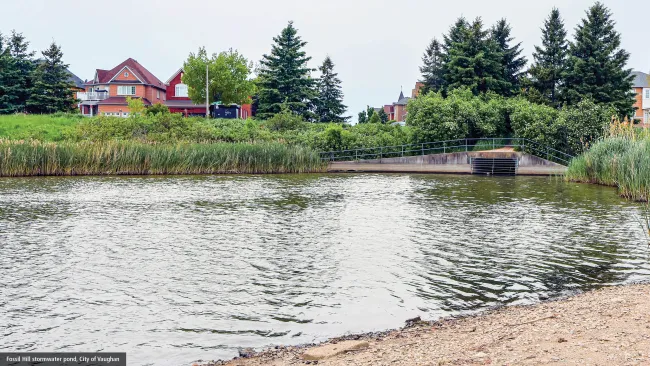‘Imagine A Day Without Water’
Let’s work together to protect and conserve this precious resource
When you turn on the tap to brush your teeth in the morning, do you think about where your water comes from? Today, the City of Vaughan joins communities across North America to recognize Imagine a Day Without Water. Through this initiative, we’re encouraging you to learn about where water comes from, the value of water and simple water conservation practices.
In Vaughan, a lot goes on behind the scenes to ensure safe and clean water comes out of the tap every time you turn it on. The City builds, maintains and rehabilitates infrastructure to provide long-lasting access to clean water, wastewater and stormwater services – an infrastructure system valued at more than $2.6 billion.
Here’s a breakdown of these systems at work!
Water
Vaughan's water comes from Lake Ontario, which is first treated by the City of Toronto and Region of Peel, then supplied to Vaughan by York Region. The City owns and operates booster stations, watermains, fire hydrants and service connections to distribute safe and clean drinking water to Vaughan residents and businesses. To learn more about the City’s water services, visit vaughan.ca/water.
Wastewater
Wastewater is “used” water sent down a drain from ordinary functions like bathing, toilet flushing and laundry. Vaughan’s wastewater moves through more than 45 kilometres of sewer pipes before it reaches York Region's Duffin Creek Treatment Plant. Treatment plants remove contaminants from wastewater and then release the treated water back into Lake Ontario. To learn more about the City’s wastewater services, visit vaughan.ca/wastewater.
Stormwater
The City’s stormwater system includes more than 1,000 kilometres of pipes, approximately 22,000 catch basins, more than 150 stormwater management ponds and more than 150 kilometres of natural creek system. Storm sewers carry stormwater (i.e. rain and melted snow) away from homes, roads and other surfaces, such as paved driveways, patios and parking lots, through catch basins. Stormwater is not treated at a treatment plant before it goes back into stormwater ponds and then the environment. To learn more about the City’s stormwater services, visit vaughan.ca/stormwater.
How you can conserve water
Water is a precious resource, and everyone can play a role in protecting and conserving it. Simple water conservation practices can save you money on your water and wastewater bill and help ensure safe and clean water for generations to come! Here are three simple practices to reduce your water use:
1. Conserve water inside and outside the home
- Reduce the amount of time you are in the shower. Every extra minute in the shower can waste 10 to 20 litres of water.
- Turn off the tap while brushing your teeth.
- Run the dishwasher and washing machine only when they are full.
- Use a broom, not a hose, to clean your driveway and walkways.
- Don't leave the hose running while washing your car.
- Use a rain barrel to collect rainwater for watering gardens.
- Plant drought-resistant trees and plants. Many thrive with far less watering and maintenance than others.
2. Protect your drinking water source
- The water that enters Vaughan’s stormwater system through catch basins goes back into local creeks, rivers and lakes, such as Lake Ontario – the source of Vaughan’s drinking water. Ensure chemicals, fertilizers, yard waste, food and other materials do not enter catch basins.
- The City’s sanitary sewer system is not designed to dispose of anything other than human waste, toilet paper and wastewater. Everyday items, such as hygiene products, wipes and food waste, should never be flushed or poured down toilets or drains.
- Fats, oils and grease should be left to cool and scraped into the green bin for safe disposal. They don’t go down the drain!
3. Check for water leaks
- Most home water leaks are silent, which makes them hard to detect. They can cause unnecessarily high water consumption, which can lead to a high water and wastewater bill and costly damage to your home if left undiscovered.
- To test for leaks on your property, record the number on your water meter before you go to bed, then avoid running sprinklers, washing machines, dishwashers or toilets overnight. In the morning, check the number on your water meter. If the number has changed, it’s because water has passed through the meter, which means you may have a leak somewhere inside or outside your home.
- The most common cause of high water and wastewater bills is toilet leaks. Visit the City’s leak prevention webpage to learn how to check for a leaky toilet, read our leak detection guide (PDF) or watch this instructional video.
For more tips on reducing your water use, visit the City’s water conservation webpage.
Recognizing the Imagine A Day Without Water initiative highlights the City’s commitment to protecting the environment and fostering a sustainable future while delivering Service Excellence, as outlined in the Council-approved 2022-2026 Term of Council Service Excellence Strategic Plan.
To learn more about the City’s water services, visit vaughan.ca/water.
For updates and news as they happen, subscribe to Vaughan News and follow the official corporate channels on X, Facebook, Instagram and LinkedIn.





